I have been visiting the Maritimes for a summer vacation every few years since the year I was born. On almost every one of those trips I have visited Peggy’s Cove in Nova Scotia. It has changed significantly over the years but one thing remains the same: it’s a great place to find Pitcher Plants and Sundews easily.
I sometimes point out these carnivorous plants to families with young children. If they are from far away they have often only seen them in magazines and on TV. Because tourists are usually distracted by the magnificent rocks and waves at Peggy’s they often overlook these small silent attractions; However when brought to their attention, many people find them just as fascinating and memorable as the lighthouse.
A Heartfelt Request for Caution and Conservation
If you decide to visit and examine these interesting plants, please be prepared to ensure they survive for others to enjoy. Don’t pick or attempt to take plants home to transplant. They are extremely sensitive to change and will die.
Also, it’s quite possible to see these plants without trampling the fragile bog ecosystem underfoot. With a bit of patience you can spot them from the paths and boardwalks. There are also locations where you can approach them closely by staying on the large weather-swept rocks. Be careful not to break off brittle lichens and small plants on the rocks. If you take your time, you can step without killing anything.
Where’s the Best Place to Easily See Pitcher Plants and Sundews at Peggy’s Cove?
Although both plants are quite common in the area, the easiest place to start your search is at the SwissAir Memorial.
Please know that some of the other guests visiting the Memorial are here because they lost loved ones in the terrible plane disaster off shore. Please be respectful.
How Can I Spot a Pitcher Plant?
The easiest of these two types of insect-eating plants to find is the Pitcher Plant. Start by looking for its flowers – either fresh darkly rust-red ones, or older withered brownish-black ones from other years. Each flower is held on a tall bare stem about 25 cm (10 inches) or higher above the ground. The flowers, which look vaguely like large buttons from the back, are big, almost 2 inches (5 cm) across.
The bulk of the plant, including the pitcher-shaped leaves will be growing beneath the flower stalk.
Once you spot one Pitcher Plant, you will suddenly start noticing they are everywhere. You will probably even start to spot the basal clumps of leaves that don’t have a flower towering overhead.
Look for a patch of pitchers near the footpath or easily accessible from a weather worn rock that is not heavily colonized by lichen. Then move in for a closer look. If you peer into the pitchers you will probably see small insects floating on the water in at least some of the leaves. Ants, spiders and even moths have also been spotted in Pitcher Plants.
What Type of Pitcher Plant Grows at Peggy’s Cove?
The type of Pitcher Plant growing in Nova Scotia is the Northern Pitcher Plant, sometimes called the Purple Pitcher Plant, Sarracenia purpurea.
What Do I Do to Find a Sundew?
Sundew plants are much less obvious. They are small wiry plants and can be easily overlooked. They are also less abundant at Peggy’s Cove than the Pitcher Plants.
Personally, I find them fastest when I start looking for reddish-pink patches near the edges of very damp but not very overgrown patches of the bog.
Round Leaf Sundews
According to the Encyclopedia of Life, this is because Round Leaf Sundews require “continually moist or wet situations.” The same source states the plants are very intolerant of shade.
The individual plants can be very small. Many are only a couple of cm across but they grow in groups perhaps 10+ cm (4+ inches) across.
They are very short plants, hugging the ground. To get a good look you need to use a telephoto lens, if standing, or you may want a macro lens or a magnifying lens if crouching.
What Kind of Sundews Grow at Peggy’s Cove?
The commonly found plant in Nova Scotia is the Round Leaf Sundew, Drosera rotundifolia. It’s the kind I see each time I visit Peggy’s.
To my surprise, I realized on a recent trip they are not the only Sundews at Peggy’s, though. There are also Spoon Leaf Sundews growing here.
Spoon Leaf Sundew
I had thought that the name “sun” dew referred to the shape of the insect-trapping part of the plant. These plants have vaguely sun-shaped tops covered in fine red filaments, radiating out like the sun’s rays, that are sticky with a secreted glue. Apparently, though, those are the round leaves.
Various websites say the name “sundew” comes from the way the plant looks wet or dew-covered when the sun shines on the insect-trapping glue. When I found out that there are other Sundews that don’t have the round leaves I realized my mistake.
Where is Peggy’s Cove?
Peggy’s Cove is located about an hour’s drive from Halifax, Nova Scotia. It faces St. Margarets Bay which opens into the North Atlantic Ocean.
Related Reading
- How and Why Do Northern Pitcher Plants “Eat” Their Prey?
- The Secrets of Sundews
- Wetlands of Nova Scotia
Join In
Have you hunted for Pitcher Plants and stumbled upon Sundews? Do you have a favourite spot to seek them out while on a summer vacation? Please share your views on carnivorous plants with a comment.


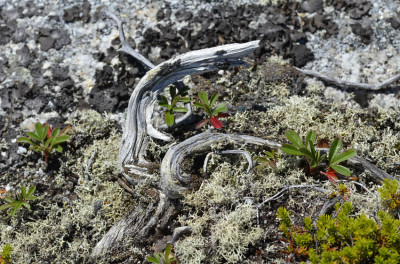
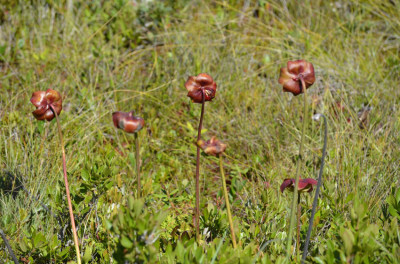
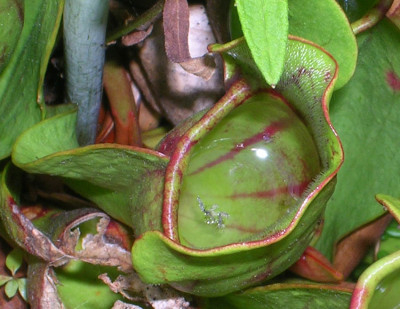
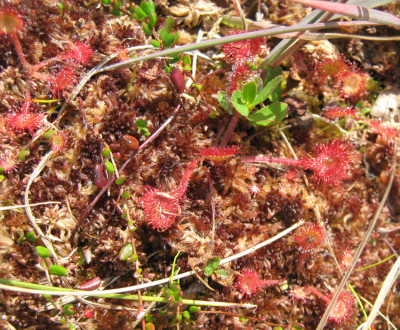
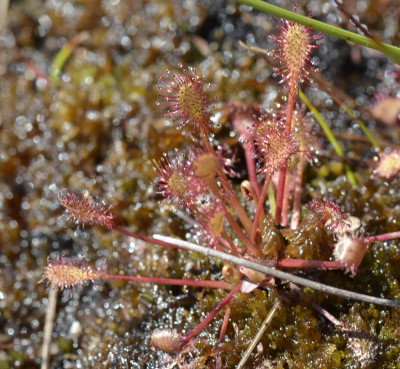
Do you know of any garden centres that carry either of these species?
No, sorry. I do know they are very hard to grow anywhere other than a bog. They only seem to digest certain types of insects well. Not all ants, for example, are safe for them. Also if they can get the nutrients they need from their soil and water they don’t grow the pitchers etc. that make them so interesting.
I found some sundews down the Dorey trail in the Annapolis Valley, very unexpected find!
Great find–thanks for sharing it with us!
Found pitcher plant at Polly Cove in March….when does the plant bloom?
Unfortunately, I don’t live in Nova Scotia so I’m not sure when the blossoming times are for plants there. I believe they bloom in July and part of August but I’m not certain. Sorry!
Bloom in June and start wilting in July
Thanks for the “insider” info!
I live in ns. I was just fishing at spider lake abd there’s thousands of pitcher plants. Looks like 2 different varieties too.
Thanks for sharing! I’d love to visit and see them some day if I can.